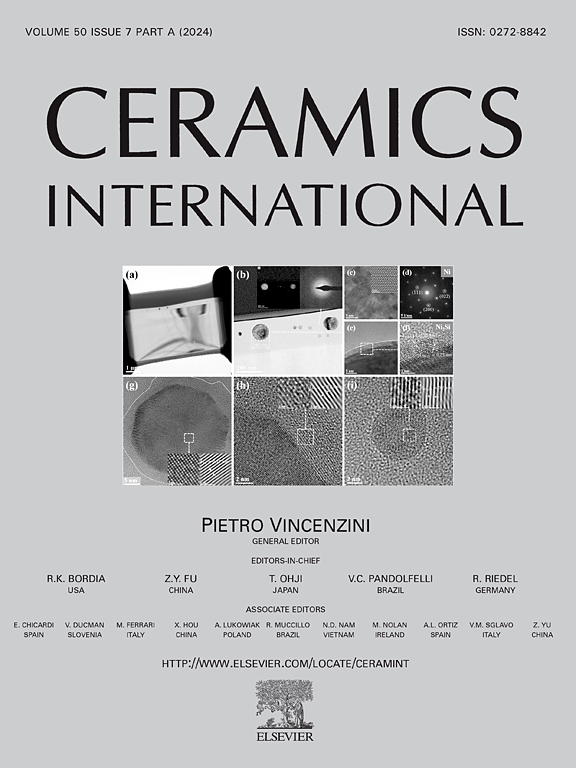Local topographical changes of Ge-(Sb)-Se thin films induced by direct electron beam writing
IF 5.6
2区 材料科学
Q1 MATERIALS SCIENCE, CERAMICS
引用次数: 0
Abstract
Local topographical changes are studied in Ge-Se and Ge-Sb-Se thin films induced by focused electron beam exposure. The results show that under comparable experimental conditions, the Ge29.2Se70.8 film undergoes expansion, while in Ge-Sb-Se compositions (Ge17.9Sb16.6Se65.5, Ge11.4Sb22.9Se65.7), the material is preferentially removed instead. Variations in electron beam parameters, including exposure time, spot size, and magnification, as well as the thermodynamic state of the thin films (virgin vs. annealed), are studied to characterize their influence on material response (height/depth of micro-objects). Force spectroscopy (FS), atomic force microscopy (AFM), energy dispersive X-ray analysis (EDX) and digital holographic microscopy (DHM) are used to characterize the micro-objects created and to identify possible changes in stiffness and chemical composition of the films studied. Observed findings demonstrate that electron beam direct writing can be used to locally modify the surface of Ge-(Sb)-Se thin films, enabling the fabrication of micro-optical elements such as microlenses.
直接电子束写入对Ge-(Sb)- se薄膜局部形貌的影响
研究了聚焦电子束辐照下锗硒和锗硒硒薄膜的局部形貌变化。结果表明:在相同的实验条件下,Ge29.2Se70.8薄膜发生膨胀,而在Ge-Sb-Se组合物(Ge17.9Sb16.6Se65.5, Ge11.4Sb22.9Se65.7)中,材料被优先去除。电子束参数的变化,包括曝光时间、光斑大小和放大倍数,以及薄膜的热力学状态(未加工与退火),被研究表征它们对材料响应(微物体的高度/深度)的影响。力谱(FS)、原子力显微镜(AFM)、能量色散x射线分析(EDX)和数字全息显微镜(DHM)用于表征所创建的微物体,并识别所研究薄膜的刚度和化学成分可能发生的变化。观察结果表明,电子束直接写入可用于局部修饰Ge-(Sb)- se薄膜表面,使微光学元件如微透镜的制造成为可能。
本文章由计算机程序翻译,如有差异,请以英文原文为准。
求助全文
约1分钟内获得全文
求助全文
来源期刊

Ceramics International
工程技术-材料科学:硅酸盐
CiteScore
9.40
自引率
15.40%
发文量
4558
审稿时长
25 days
期刊介绍:
Ceramics International covers the science of advanced ceramic materials. The journal encourages contributions that demonstrate how an understanding of the basic chemical and physical phenomena may direct materials design and stimulate ideas for new or improved processing techniques, in order to obtain materials with desired structural features and properties.
Ceramics International covers oxide and non-oxide ceramics, functional glasses, glass ceramics, amorphous inorganic non-metallic materials (and their combinations with metal and organic materials), in the form of particulates, dense or porous bodies, thin/thick films and laminated, graded and composite structures. Process related topics such as ceramic-ceramic joints or joining ceramics with dissimilar materials, as well as surface finishing and conditioning are also covered. Besides traditional processing techniques, manufacturing routes of interest include innovative procedures benefiting from externally applied stresses, electromagnetic fields and energetic beams, as well as top-down and self-assembly nanotechnology approaches. In addition, the journal welcomes submissions on bio-inspired and bio-enabled materials designs, experimentally validated multi scale modelling and simulation for materials design, and the use of the most advanced chemical and physical characterization techniques of structure, properties and behaviour.
Technologically relevant low-dimensional systems are a particular focus of Ceramics International. These include 0, 1 and 2-D nanomaterials (also covering CNTs, graphene and related materials, and diamond-like carbons), their nanocomposites, as well as nano-hybrids and hierarchical multifunctional nanostructures that might integrate molecular, biological and electronic components.
 求助内容:
求助内容: 应助结果提醒方式:
应助结果提醒方式:


